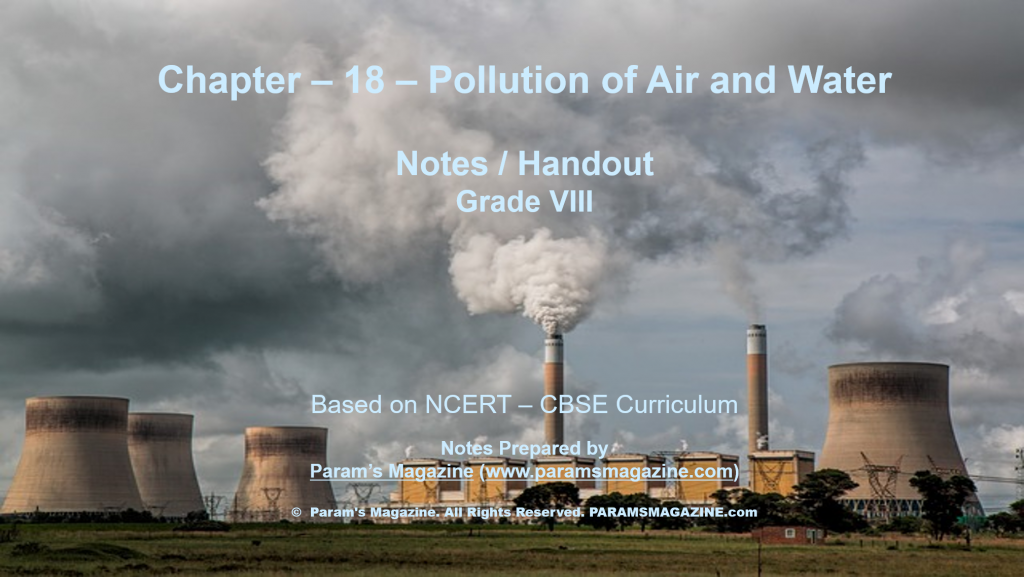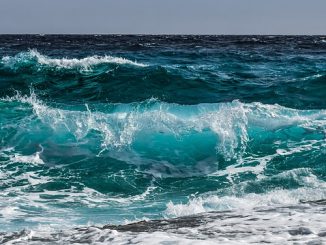
Notes / Handout – Pollution of Air and Water – Chapter-18 – Science – NCERT / CBSE – Class VIII
Air
- Air consists of a mixture of gases. By volume,
- about 78% of this mixture is nitrogen and
- about 21% is oxygen.
- Carbon dioxide, argon, methane, ozone and water vapour are also present in very small quantities.
Air Pollution
When air is contaminated by unwanted substances which have a harmful effect on both the living and the non-living, it is referred to as air pollution.
Air pollutants
- The substances which contaminate the air are called air pollutants.
- Sometimes, such substances may come from natural sources like smoke and dust arising from forest fires or volcanic eruptions.
- Pollutants are also added to the atmosphere by certain human activities.
- The sources of air pollutants are;
- factories
- power plants
- automobile exhausts
- burning of firewood
- dung cakes.
- Vehicles produce high levels of pollutants like;
- carbon monoxide,
- carbon dioxide,
- nitrogen oxides and
- smoke
Carbon monoxide
- CO is produced from incomplete burning of fuels such as petrol and diesel.
- It is a poisonous gas.
- It reduces the oxygen-carrying capacity of the blood.
Smog
The smog causes breathing difficulties such as asthma, cough and wheezing in children.
Sulphur dioxide and nitrogen dioxide
- Many industries are also responsible for causing air pollution.
- Petroleum refineries are a major source of gaseous pollutants like sulphur dioxide and nitrogen dioxide.
Sulphur dioxide is produced by combustion of fuels like coal in power plants. It can cause respiratory problems, including permanent lung damage.
Chlorofluorocarbons (CFCs)
- Chlorofluorocarbons (CFCs) are used in refrigerators, air conditioners and aerosol sprays.
- CFCs damage the ozone layer of the atmosphere. The ozone layer protects us from harmful ultraviolet rays of the sun.
- Less harmful chemicals are now being used in place of CFCs.
Dust Particles
- In addition to the above pollutants,
- automobiles which burn diesel and petrol, also produce tiny particles which remain suspended in air for long periods.
- Such particles are also produced during industrial processes like steel making and mining.
- Power plants give out tiny ash particles which also pollute the atmosphere.
- They reduce visibility.
- When inhaled, they cause diseases.
Taj Mahal
- Experts have warned that pollutants in air are discolouring its white marble. It is not only living organisms that get affected by polluted air but also non-living things like the following are affected;
- buildings
- monuments and
- statues
- The industries located in and around Agra like the following have been responsible for producing pollutants like sulphur dioxide and nitrogen dioxide.
- rubber processing industries,
- automobile industries,
- chemical industries and
- the Mathura oil refinery
- Acid Rain
- These gases (Sulphur dioxide and Nitrogen dioxide) react with the water vapour present in the atmosphere to form sulphuric acid and nitric acid. The acids drop down with rain, making the rain acidic. This is called acid rain.
- Marble Cancer
- Acid rain corrodes the marble of the monument. The phenomenon is also called “Marble cancer”.
- Suspended particulate matter, such as the soot particles emitted by Mathura oil refinery, has contributed towards the yellowing of the marble.
- The Supreme Court has taken several steps to save the Taj. It has ordered industries to switch to cleaner fuels like CNG (Compressed Natural Gas) and LPG (Liquefied Petroleum Gas).
- The automobiles should switch over to unleaded petrol in the Taj zone.
Global Warming
- Deforestation – Plants utilise Carbon dioxide (CO2) from the atmosphere for photosynthesis, thereby decreasing/controlling the amount of CO2 in the air. But, CO2 is continuously being released because of human activities. On the other hand, area under forests is decreasing.
- Deforestation leads to an increase in the amount of CO2 in the air as the number of trees consuming CO2 is reduced. Thus, human activities, contribute to the accumulation of CO2 in the atmosphere.
- CO2 traps heat and does not allow it to escape into space. As a result, the average temperature of the earth’s atmosphere is gradually increasing. This is called global warming.
- Other gases like methane, nitrous oxide and water vapour also contribute towards this effect. Like CO2, they are also called greenhouse gases.
Global Warming – A serious threat!
- Global warming can cause sea levels to rise dramatically. In many places coastal areas have already been flooded.
- It could result in wide ranging effects on rainfall patterns, agriculture, forests, plants and animals.
- Many regions in Asia are affected by global warming
- A recent climate change report gives us only a limited time to keep the greenhouse gases at the present level.
- Otherwise, the temperature may rise by more than 2 degrees Celsius by the end of the century, a level considered dangerous.
- Kyoto Protocol: Global warming has become a major concern for governments worldwide. Many countries have reached an agreement to reduce the emission of greenhouse gases. The Kyoto Protocol s one such agreement.
Water Pollution
Water Pollutants
- Water gets polluted when harmful pollutants like the following are mixed with the water;
- sewage
- toxic chemicals
- silt
Industries that Pollute River Water
- Fertiliser industries
- Detergent industries
- Leather industries
- Paint industries
- Oil Refineries
- Paper factories
- Textile mills
- Sugar Mills
- Chemical Factories
The Toxic chemicals released in the waste water from Industries
The release of waste water containing toxic substances in to the water bodies, results in destruction of aquatic plants and animals. Some of the toxic elements released from the industries are;
- Arsenic
- Lead
- Fluorides
Other Pollutants of Water bodies
- Garbage
- Food wastes
- Untreated sewage water
- Dead animal and plant wastes
- Faecal matter
Potable Water
- Water that is suitable for drinking is called potable water.
- Methods by which the water is made safe for drinking:
- Using candle type water filters
- Boiling of drinking water
- Chlorination
How to prevent Water Pollution?
- Installation of water treatment plants in industrial areas
- Following 3 Rs (Reduce, Reuse and Recycle)



Be the first to comment